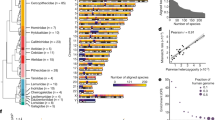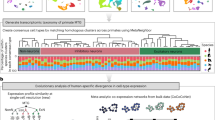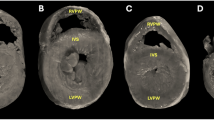Abstract
Many human diseases are the result of early developmental defects. As most paediatric diseases and disorders are rare, children are critically underrepresented in research. Functional genomics studies primarily rely on adult tissues and lack critical cell states in specific developmental windows. In parallel, little is known about the conservation of developmental programmes across non-human primate (NHP) species, with implications for human evolution. Here we introduce the developmental Genotype-Tissue Expression (dGTEx) projects, which span humans and NHPs and aim to integrate gene expression, regulation and genetics data across development and species. The dGTEx cohort will consist of 74 tissue sites across 120 human donors from birth to adulthood, and developmentally matched NHP age groups, with additional prenatal and adult animals, with 126 rhesus macaques (Macaca mulatta) and 72 common marmosets (Callithrix jacchus). The data will comprise whole-genome sequencing, extensive bulk, single-cell and spatial gene expression profiles, and chromatin accessibility data across tissues and development. Through community engagement and donor diversity, the human dGTEx study seeks to address disparities in genomic research. Thus, dGTEx will provide a reference human and NHP dataset and tissue bank, enabling research into developmental changes in expression and gene regulation, childhood disorders and the effect of genetic variation on development.
This is a preview of subscription content, access via your institution
Access options
Access Nature and 54 other Nature Portfolio journals
Get Nature+, our best-value online-access subscription
27,99 € / 30 days
cancel any time
Subscribe to this journal
Receive 51 print issues and online access
199,00 € per year
only 3,90 € per issue
Buy this article
- Purchase on SpringerLink
- Instant access to full article PDF
Prices may be subject to local taxes which are calculated during checkout



Similar content being viewed by others
References
Lonsdale, J. et al. The genotype-tissue expression (GTEx) project. Nat. Genet. 45, 580–585 (2013). This paper outlines the original GTEx project, the predecessor of the dGTEx projects.
GTEx Consortium. The GTEx Consortium atlas of genetic regulatory effects across human tissues. Science 369, 1318–1330 (2020).
eGTEx Project. Enhancing GTEx by bridging the gaps between genotype, gene expression, and disease. Nat. Genet. 49, 1664–1670 (2017).
Kim-Hellmuth, S. et al. Cell type-specific genetic regulation of gene expression across human tissues. Science 369, eaaz8528 (2020). This paper illustrates the variation of genetic effects on gene regulation between cell types from GTEx data.
Ferraro, N. M. et al. Transcriptomic signatures across human tissues identify functional rare genetic variation. Science 369, eaaz5900 (2020).
Oliva, M. et al. The impact of sex on gene expression across human tissues. Science 369, eaba3066 (2020).
Rozenblatt-Rosen, O., Stubbington, M. J. T., Regev, A. & Teichmann, S. A. The Human Cell Atlas: from vision to reality. Nature 550, 451–453 (2017). This paper outlines the conceptual framework for the Human Cell Atlas, a comprehensive reference map of cell types through application of single-cell technologies to dissect cellular functions, interactions and tissue organization, with significant implications for advancing our understanding of human biology.
HuBMAP Consortium. The human body at cellular resolution: the NIH Human Biomolecular Atlas Program. Nature 574, 187–192 (2019).
Emani, P. S. et al. Single-cell genomics and regulatory networks for 388 human brains. Science 384, eadi5199 (2024).
Rao, A., Barkley, D., França, G. S. & Yanai, I. Exploring tissue architecture using spatial transcriptomics. Nature 596, 211–220 (2021).
Shahbazi, M. N. Mechanisms of human embryo development: from cell fate to tissue shape and back. Development 147, dev190629 (2020).
Haniffa, M. et al. A roadmap for the Human Developmental Cell Atlas. Nature 597, 196–205 (2021).
Taylor, D. M. et al. The Pediatric Cell Atlas: defining the growth phase of human development at single-cell resolution. Dev. Cell 49, 10–29 (2019).
Mukhopadhyay, N. et al. Whole genome sequencing of orofacial cleft trios from the Gabriella Miller Kids First Pediatric Research Consortium identifies a new locus on chromosome 21. Hum. Genet. 139, 215–226 (2020).
Zaidi, S. et al. De novo mutations in histone-modifying genes in congenital heart disease. Nature 498, 220–223 (2013).
Priest, J. R. et al. De novo and rare variants at multiple loci support the oligogenic origins of atrioventricular septal heart defects. PLoS Genet. 12, e1005963 (2016).
Short, P. J. et al. De novo mutations in regulatory elements in neurodevelopmental disorders. Nature 555, 611–616 (2018).
Coorens, T. H. H. & Behjati, S. Tracing and targeting the origins of childhood cancer. Annu. Rev. Cancer Biol. 6, 35–47 (2022).
Filbin, M. & Monje, M. Developmental origins and emerging therapeutic opportunities for childhood cancer. Nat. Med. 25, 367–376 (2019).
Zheng, X. et al. Risk of metabolic syndrome in adults exposed to the great Chinese famine during the fetal life and early childhood. Eur. J. Clin. Nutr. 66, 231–236 (2012).
Ning, F. et al. Famine exposure in early life and risk of metabolic syndrome in adulthood: Comparisons of different metabolic syndrome definitions. J. Diabetes Res. 2019, 7954856 (2019).
Grey, K. et al. Severe malnutrition or famine exposure in childhood and cardiometabolic non-communicable disease later in life: a systematic review. BMJ Glob. Health 6, e003161 (2021).
Day, F. R. et al. Genomic analyses identify hundreds of variants associated with age at menarche and support a role for puberty timing in cancer risk. Nat. Genet. 49, 834–841 (2017).
Day, F. R. et al. Shared genetic aetiology of puberty timing between sexes and with health-related outcomes. Nat. Commun. 6, 8842 (2015).
The elephant in the room. Nature 444, 790 (2006).
Tardif, S., Carville, A., Elmore, D., Williams, L. E. & Rice, K. in Nonhuman Primates in Biomedical Research Vol. 1 (eds Abee, C. R. et al.) 197–249 (Elsevier, 2012).
Tardif, S. D. & Ross, C. N. in The Common Marmoset in Captivity and Biomedical Research (eds Marini, R. et al.) 119–132 (Academic Press, 2019).
Lewis, A. D. & Prongay, K. in The Nonhuman Primate in Nonclinical Drug Development and Safety Assessment (eds Bluemel, J. et al.) 87–113 (Academic Press, 2015).
Lemke, A. A. et al. Addressing underrepresentation in genomics research through community engagement. Am. J. Hum. Genet. 109, 1563–1571 (2022). This paper highlights the need to address underrepresented populations within genomic research and how community engagement can aid in confronting this issue.
Rood, J. E. et al. Toward a common coordinate framework for the human body. Cell 179, 1455–1467 (2019).
Burger, A. et al. Towards a clinically-based common coordinate framework for the human gut cell atlas: the gut models. BMC Med. Inform. Decis. Mak. 23, 36 (2023).
Börner, K. et al. Construction and usage of a human body Common Coordinate Framework comprising clinical, semantic, and spatial ontologies. Preprint at https://doi.org/10.48550/arXiv.2007.14474 (2020).
Ardini-Poleske, M. E. et al. LungMAP: the molecular atlas of lung development program. Am. J. Physiol. 313, L733–L740 (2017).
Reid, W. Height and weight in human beings. Autopsy report. J. Clin. Pathol. 41, 237–237 (1988).
Schulz, D. M., Giordano, D. A. & Schulz, D. H. Weights of organs of fetuses and infants. Arch. Pathol. 74, 244–250 (1962).
Al’Khafaji, A. M. et al. High-throughput RNA isoform sequencing using programmed cDNA concatenation. Nat. Biotechnol. 42, 582–586 (2024).
Glinos, D. A. et al. Transcriptome variation in human tissues revealed by long-read sequencing. Nature 608, 353–359 (2022).
Grün, D. & van Oudenaarden, A. Design and analysis of single-cell sequencing experiments. Cell 163, 799–810 (2015).
Buenrostro, J. D., Giresi, P. G., Zaba, L. C., Chang, H. Y. & Greenleaf, W. J. Transposition of native chromatin for fast and sensitive epigenomic profiling of open chromatin, DNA-binding proteins and nucleosome position. Nat. Methods 10, 1213–1218 (2013).
Buenrostro, J. D. et al. Single-cell chromatin accessibility reveals principles of regulatory variation. Nature 523, 486–490 (2015).
Qiu, X. et al. Reversed graph embedding resolves complex single-cell trajectories. Nat. Methods 14, 979–982 (2017).
Satpathy, A. T. et al. Massively parallel single-cell chromatin landscapes of human immune cell development and intratumoral T cell exhaustion. Nat. Biotechnol. 37, 925–936 (2019).
Schep, A. N., Wu, B., Buenrostro, J. D. & Greenleaf, W. J. chromVAR: inferring transcription-factor-associated accessibility from single-cell epigenomic data. Nat. Methods 14, 975–978 (2017).
Zhu, C., Preissl, S. & Ren, B. Single-cell multimodal omics: the power of many. Nat. Methods 17, 11–14 (2020).
Stuart, T. et al. Comprehensive integration of single-cell data. Cell 177, 1888–1902.e21 (2019).
Wang, S. K. et al. Single-cell multiome of the human retina and deep learning nominate causal variants in complex eye diseases. Cell Genom. 2, 100164 (2022).
Bravo González-Blas, C. et al. SCENIC+: single-cell multiomic inference of enhancers and gene regulatory networks. Nat. Methods 20, 1355–1367 (2023).
Cang, Z. et al. Screening cell–cell communication in spatial transcriptomics via collective optimal transport. Nat. Methods 20, 218–228 (2023).
Castel, S. E. et al. A vast resource of allelic expression data spanning human tissues. Genome Biol. 21, 234 (2020).
Mao, Y. et al. Structurally divergent and recurrently mutated regions of primate genomes. Cell 187, 1547–1562 (2024).
He, Y. et al. Long-read assembly of the Chinese rhesus macaque genome and identification of ape-specific structural variants. Nat. Commun. 10, 4233 (2019).
Makova, K. D. et al. The complete sequence and comparative analysis of ape sex chromosomes. Nature 630, 401–411 (2024).
Zhang, X. et al. Towards a primate single-cell atlas. Zool. Res. 43, 691–694 (2022).
Han, L. et al. Cell transcriptomic atlas of the non-human primate Macaca fascicularis. Nature 604, 723–731 (2022).
Qu, J. et al. A reference single-cell regulomic and transcriptomic map of cynomolgus monkeys. Nat. Commun. 13, 4069 (2022).
Luecken, M. D. et al. Benchmarking atlas-level data integration in single-cell genomics. Nat. Methods 19, 41–50 (2022).
Sikkema, L. et al. An integrated cell atlas of the lung in health and disease. Nat. Med. 29, 1563–1577 (2023).
Hrovatin, K. et al. Integrating single-cell RNA-seq datasets with substantial batch effects. Preprint at bioRxiv https://doi.org/10.1101/2023.11.03.565463 (2023).
Rosen, Y. et al. Toward universal cell embeddings: integrating single-cell RNA-seq datasets across species with SATURN. Nat. Methods 21, 1492–1500 (2024).
Cao, J. et al. A human cell atlas of fetal gene expression. Science 370, eaba7721 (2020).
Zhai, J. et al. Primate gastrulation and early organogenesis at single-cell resolution. Nature 612, 732–738 (2022).
Taliun, D. et al. Sequencing of 53,831 diverse genomes from the NHLBI TOPMed Program. Nature 590, 290–299 (2021).
van der Wijst, M. et al. The single-cell eQTLGen consortium. eLife 9, e52155 (2020).
Deciphering Developmental Disorders Study. Large-scale discovery of novel genetic causes of developmental disorders. Nature 519, 223–228 (2015).
Housman, G. & Gilad, Y. Prime time for primate functional genomics. Curr. Opin. Genet. Dev. 62, 1–7 (2020).
Pollard, K. S. et al. An RNA gene expressed during cortical development evolved rapidly in humans. Nature 443, 167–172 (2006).
Prabhakar, S. et al. Human-specific gain of function in a developmental enhancer. Science 321, 1346–1350 (2008).
Tukiainen, T. et al. Landscape of X chromosome inactivation across human tissues. Nature 550, 244–248 (2017).
Werner, J. M., Ballouz, S., Hover, J. & Gillis, J. Variability of cross-tissue X-chromosome inactivation characterizes timing of human embryonic lineage specification events. Dev. Cell 57, 1995–2008.e5 (2022).
Wang, Q. et al. Unifying cancer and normal RNA sequencing data from different sources. Sci. Data 5, 180061 (2018).
Yizhak, K. et al. RNA sequence analysis reveals macroscopic somatic clonal expansion across normal tissues. Science 364, eaaw0726 (2019).
Rockweiler, N. B. et al. The origins and functional effects of postzygotic mutations throughout the human life span. Science 380, eabn7113 (2023).
Roberts, V. H. J. et al. Rhesus macaque fetal and placental growth demographics: A resource for laboratory animal researchers. Am. J. Primatol. 85, e23526 (2023).
Acknowledgements
This research is supported by the National Human Genome Research Institute (NHGRI), the Eunice Kennedy Shriver National Institute of Child Health and Human Development (NICHD), the National Institute of Neurological Disorders and Stroke (NINDS), the National Institute of Mental Health (NIMH) and the Office of Research Infrastructure Programs under awards U24 HD106537, U24 HG012090, U24 HG012108 and U24 HG012483. T.H.H.C. is supported by an EMBO long-term fellowship (ALTF 172-2022). We thank the donors and their families for making this study possible. The views and opinions expressed in this manuscript are those of the authors only and do not necessarily represent the views, official policy or position of the US Department of Health and Human Services or any of its affiliated institutions or agencies.
Author information
Authors and Affiliations
Consortia
Corresponding authors
Ethics declarations
Competing interests
The authors declare no competing interests.
Peer review
Peer review information
Nature thanks Rachel Freathy and the other, anonymous, reviewer(s) for their contribution to the peer review of this work.
Additional information
Publisher’s note Springer Nature remains neutral with regard to jurisdictional claims in published maps and institutional affiliations.
Supplementary information
Rights and permissions
Springer Nature or its licensor (e.g. a society or other partner) holds exclusive rights to this article under a publishing agreement with the author(s) or other rightsholder(s); author self-archiving of the accepted manuscript version of this article is solely governed by the terms of such publishing agreement and applicable law.
About this article
Cite this article
Coorens, T.H.H., Guillaumet-Adkins, A., Kovner, R. et al. The human and non-human primate developmental GTEx projects. Nature 637, 557–564 (2025). https://doi.org/10.1038/s41586-024-08244-9
Received:
Accepted:
Published:
Issue Date:
DOI: https://doi.org/10.1038/s41586-024-08244-9
This article is cited by
-
Integrating ELSI study teams in paediatric genomic research efforts
Nature Reviews Genetics (2025)
-
A community-led initiative to de-risk and advance Parkinson’s disease therapeutic targets
npj Parkinson's Disease (2025)



